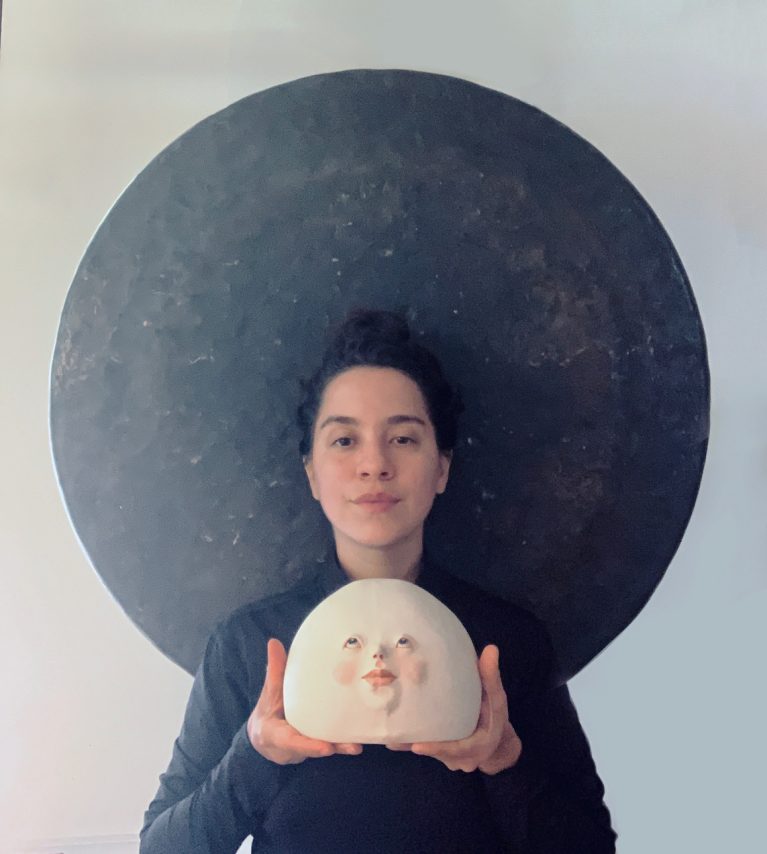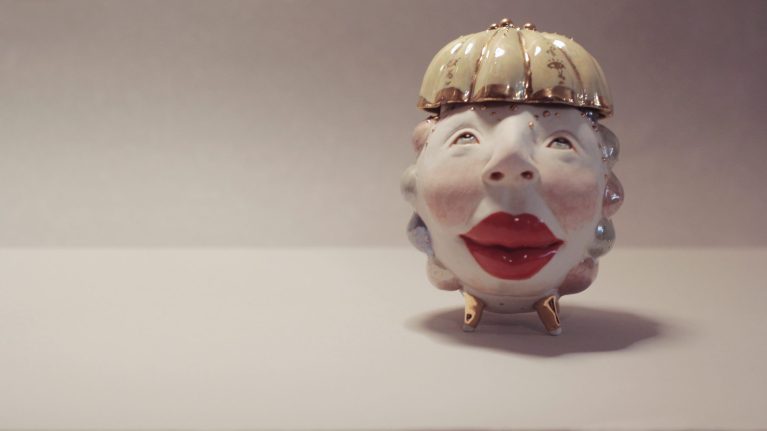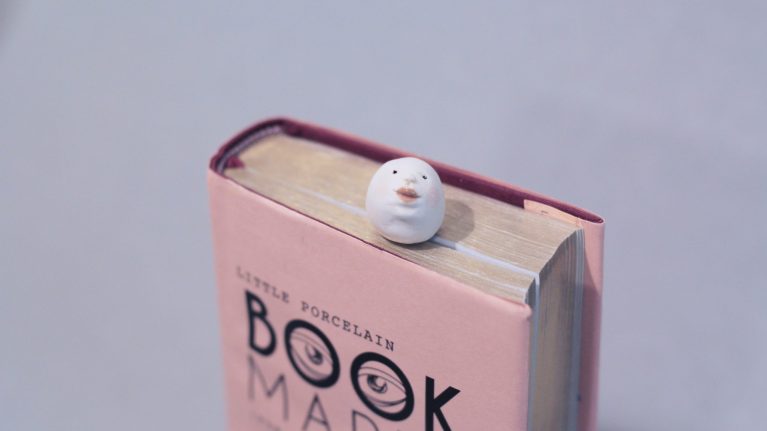Ogden Museum of Southern Art
925 Camp St
New Orleans, LA 70130
504.539.9650 | HOURS
925 Camp St
New Orleans, LA 70130
504.539.9650 | HOURS

Nathalia Toledo Barcia, Bubble Boy, Porcelain sculpture, 2021, Image courtesy of Nathalia Toledo Barcia
What is your name? How do you like to be addressed?
I’m Nathalia Toledo Barcia, my pronouns are she/her and I’m a ceramicist and a painter. My neocraft ceramics brand is Kuri Mayai.
Where are you from? What brought you to the South?
I was born and raised in Ecuador. Destiny brought me to the USA, first to New Jersey and then Miami to be with my dad. After quitting my job as a designer and traveling for several years, I decided to pursue a career in Arts in the USA. New Orleans was recommended to me as a wonderful city for an artist to live in, so I decided to move to New Orleans. Immediately, I fell in love with the culture, music and magical atmosphere. Of course, this is all-inclusive warmth and perseverance of the people of New Orleans, always positive and willing to salute anyone with a big smile and a “How you doing baby!” I felt welcomed in this multicultural and multiethnic cosmopolitan city. Then I fell in love and I’ve been living here the last four years with my partner Zach.
How does where you are from inform your work?
I consider myself a citizen of the world or a human from the third planet because I prefer small villages to big cities. Being from a plurinational country with a great indigenous population has gifted me ancestral knowledge. As a ceramicist, I transform the elemental clay to a perceptible substance of the vision that was opened by some of my experiences with the indigenous people of the Ecuadorian Amazon.
What do you think makes your work unique?
My work with ceramics came from studying and replicating pre-Columbian artifacts that were not only beautiful but possessed functional and ritual characteristics. These pieces were part of everyday life– they produced sound and were used with intention during ceremonies. Many of those artifacts have prevailed throughout time and can be seen today in museums. Since I was a kid, I was fascinated by those pieces and by how something that looks so fragile could survive thousands of years to be admired today. The people of my home country, my ancestors, had burial rituals in which they placed the body inside a clay pot and buried it in the mountains. Those bodies were returned to Earth, to the intimate womb of the original Mother. Ceramics have an inherent magic and mystery to them.
Coming from a plurinational country, I interpret the multicultural dialogue that still exists. For example, I try to reflect the ancestral knowledge of “Aents,” the native Amazonian nation of Ecuador. This word means that everything is alive– humans, animals, plants, objects, supernatural beings, etc. and interconnected in its life. The word itself insinuates that every living thing has power. I invoke this when I create art with a pure intention to bring soul to objects and transmit “Aents” to everyone. I hope that one day my artifacts can survive the transition of time much like those ancient artifacts that I experience in museums today.
Did you face any obstacles becoming a ceramicist and how did you overcome them?
I learned the basics of ceramics in a 3-month workshop with pre-Columbian technologies and techniques, using earth pigments and rustic clays that were completely hand mixed and where you could see traces of minerals and soil. My teachers were museum anthropologists who restored these ceramics. When I moved to the USA I learned to experiment with the new materials I found here. I learned through observation and a lot of trial and error! I was exposed to new sculpting techniques, glazes and different clay bodies. It was a challenge but eventually I found porcelain as my main medium. In the end, it was worth the journey as experience transforms an artist into a master. Patience is necessary because it takes a long time, sometimes a lifetime. I have a long way to go to consider myself a master, but it’s a goal, a dream I can achieve.
Patience, letting things go, and accepting reality have all been part of the process as much as the minerals that make up the clay. There is frustration and sadness when an artwork cracks in the last fire or doesn’t come out as I imagined. In that challenge there is a lesson in slowing down. After all, the earth that makes up these pieces has been around for a long time. The earth has a way of reminding us to slow down.
Another obstacle was navigating the art community as an immigrant whose second language was English. At first it was difficult to be able to find a kiln for rent in New Orleans. All studios asked for memberships. My partner helped me overcome many of these obstacles and eventually I was able to buy my own kiln!
What’s your favorite piece that you’ve made so far?
It’s difficult to pick a favorite, but if I had to it would be Silent Rack, my last creation of a series of whistle ocarinas, which is a wind musical instrument. The ones that I made are all face-ball figures. Except this rack does not make sound as it is intended. Ironically, this one was made to be silent.

Nathalia Toledo Barcia, Silent Rack, Porcelain sculpture with separated crown, 2022
How long did it take for your work to progress to the level it is currently? Do you consider how it’ll progress in the future?
I still have my first pre-Columbian replicas and ocarinas from 2014 when I took the workshop. After working on those first pieces, I traveled around Asia for some years, learning Batik on the island of Java and Thangka painting in Ladakh. In 2018, I was living in the USA and found time and the space to work on my art. Finally, I started to fully create more. I still have some pieces from those early days. Some were well-sculpted for a beginner but terribly painted because I didn’t understand the chemical reactions of glazing yet. I’ve been continuously creating for a little more than four years. Hopefully,if I stay diligent I will continue to improve and grow in my art journey. I will create as long as I keep dreaming and having visions of beautiful objects.
Tell me about your journey as an artist. How did you get where you are today?
Learning and the pursuit of inspiration have kept me traveling and studying around the world. Coming from Ecuador, a pluri-national country, my major interests in life are ancestral culture and traditions, classical art, and cooking. My artistic career started at the age of 8 when I was admitted to study classical music at the National Conservatory of Music in the city of Guayaquil, Ecuador. Studying music for 12 years, I graduated as a piano teacher, already teaching since I was 15. Free to pursue studying other art forms, I moved on to study graphic design and fine arts at ESPOL in Ecuador.
After graduating, I started to work at advertising agencies for several years. Realizing that I wanted more time to pursue creating art, I quit my job and went to study in 2011 Etching and Engraving with the artist Alejandra Winkhaus in Buenos Aires, Argentina. Afterwards, I returned to ESPOL, getting my Bachelor’s degree in Arts specialized in Audiovisual Production. In 2014, I studied Pre-columbian ceramics at the MAAC, discovering my passion for working with clay. The same year I won a scholarship to study traditional art and Batik at a Universitas Negeri Semarang in Indonesia, with Rodia Syamwil. The interest in ancestral arts would bring me on further travels to learn Thangka Painting in Ladakh, India and visiting small villages around Asia to get inspired with their creations.
In 2018, I moved from New Orleans to the Northshore to live with my partner Zach, where I work in ceramics at my home studio under the name Kuri Mayai. A little over a year ago, I started to participate in local art markets in the city of New Orleans and Covington. I believe I am still very early on my path as an artist, but all my travels, stories, people I’ve found in my path have placed me where I am today. For this, I am grateful.
What kind of impression do you hope someone observing your work gets?
I hope when someone’s eye meets my art-things, my creations stare back at them—almost all my pieces have faces—in silence. I hope that they perceive the force of the art piece, that they feel its life and power. Usually people approach them cautiously— peoples’ reactions at local Art Markets range from, loving the expressive eyes, to iIt’s weird but I like it” to “it’s whimsical!” I really love the way that children react to them– opening their eyes in awe when they see them! I think, “good they get the message”.
What other artists inspire you and your work?
I am inspired by artists from the past like Van Gogh (not only his paintings but his mind and poetic words), the naiveness or ingenuity of Toulouse Lautrec and the splendid visuals of Magritte. I also admire Frida Kahlo and her unique way to transform her struggles, her powerful compositions and a timeless sense of style. A living artist who inspires me is Felicia Chiao who creates a very special dialogue between her inner alter-ego and mental health. I am also very impressed with the technique and work of Hayv Kahraman and her experience of being a refugee and transforming the fight of her people into art. A ceramicist I really admire is Johnson Tsang and I hope one day I can achieve that level of perfection in my work.

Nathalia Toledo Barcia, lulu moon, Porcelain whistle ocarina, 2020
Should lines be drawn between “fine art” and “craft?” How do you define separation/what does it mean for you? Is it restrictive? Do you like the distinction?
South America has a very rich culture in different crafts, but my travels in Asia studying traditional art have left a strong influence in regards to patterns, textiles, techniques and influence of what has traditionally been known as “craft.”
From my travels, I’ve found that if it is handmade and unique, it should be considered art. I remember being crazy about going to Dhordo village in the Rann of Kutch to see the art made with tiny mirrors. They use it not only on mosaics and murals, but in textiles as well, and this wonderful lady corrected me when I was fascinated looking at her fabrics, where she sewed little mirrors and the colors of the threads were unbelievable. For me it was a perfect composition and design (for sure took a lot of time to be made) and I told my friend “it’s like art,” and the lady in a sweet but serious way told me, “That it is art, I’m an artist.” From that day, I refused to make distinctions between art and handmade crafts.
To me, the only way it is a handicraft and not a more elevated art piece is the means of production. If something is mass produced by machines and sold in crafts markets by people who are not the makers, then it’s no longer art.
My mind has been blown away so many times looking at the textiles from indigenous people of my country. The finest Panama hats are made in Ecuador and can take over 6 months to finish. Being able to see how batik is made or the handmade Kashmiri pashmina shawls with perfect embroidery that could be used both ways of the fabric, has widened my views and elevated what others may see as “craft” to its rightful place as art.
Did you consider pursuing a medium other than ceramics? Or do you pursue other mediums beyond ceramics? If so, how do the two inform each other?
I am a painter too and I’ve studied engraving in Buenos Aires and batik in Java. I combine some of these techniques to express myself as well. I’m very patient with under-glazing my ceramics first and I paint it like if I’m working on canvas.
How can people continue to follow your work and career?
I’ve started to work on paintings again. I will keep doing ceramics but I have postponed the creation of bigger pieces that are just going to be one unique piece and not a part of a series.I hope that by the end of the year I will have some paintings and at least one big sculpture. Right now I’m working on creating my webpage but it is going to take a while, so the best way to find me is through social media, especially on Instagram @kurimayai. Please send me a message if you want to discuss any of my artwork or just want to check in!
You can view Nathalia Toledo Barcia’s work in this year’s Art of the Cup, on view at Ogden Museum of Southern Art September 24 to November 28, 2022.
Learn more about Art of the Cup